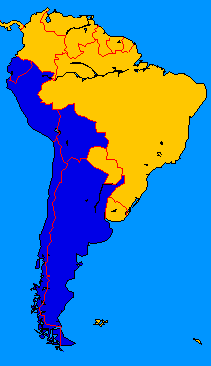The Vicuña
(Vicugna Vicugna)
(Note: Due to the use of special text characters, this page is best viewed with a browser that correctly displays the ISO Latin 1 character set.)
Future Quote
Anon.
Description
The vicuña, a small animal with fine cinnamon fleece and a delicate white bib, is the smallest of the six camelid species in the world today, and one of two wild varieties native to South America.
It is distinguished from the guanaco, the other wild species, by a more slender build, a shorter head, and the absence of bare callosities on the hind legs.
Their remarkably long, fine, soft and lusterous wool is highly valued for weaving. The term vicuña is also used to refer to cloth made from vicuña fleece and to immitations thereof.
The Vicuñ is protected by the Convention on International Trade in Wild Fauna and Flora (CITES), indicating the species may become endangered if trade in specimens of the animal are not controlled.
Originally listed in Appendix 1 of the treaty on July 1, 1975, a rise in the number of animals allowed transfer of some populations to Appendix II in 1987. Some more populations were transferred to Appendix II in 1995. Finally, all remaining populations were placed in Appendix II on September 18, 1997.
The 1997 IUCN Red List classifies the Vicuñ as low risk, but conservation dependant. This means that, in the opinion of IUCN, if conservation programs for the species were terminated, the vicuña could be reclassified as threatened within five years.
Argentina, Bolivia, Chile, Ecuador, and Peru are party to the Convention for the Conservation and Management of the Vicuña, signed in 1979 in Lima, Peru. The Convention brings the vicuña under strict state control, prohibits hunting and illegal trade, and provides for the establishment of parks, reserves, and other protected areas.
Under the terms of the treaty, the vicuña was introduced into Ecuador from Chile and Peru in 1988.
Natural Range

The vicuña is native to the Andes of South America.
There are herds of wild vicuña in Argentina, Bolivia, Chile, Ecuador, and Peru.
Population Trends
Argentina
Decreasing
Bolivia
Unknown
Chile
Unknown
Ecuador
Increasing
Peru
Unknown
Data from UN-FAO-DAD:
July 25, 1999
Physical Facts
- Life Span -
- Height -
- Weight -
- Gestation -
- Birth -
- Babies -
- Reproduction -
- Colour -
- Health -
Taxonomy
Phylum
Chordata
Class
Mammalia
Order
Artiodactyla
Sub-order
Tylopoda
Family
Camelidae
Genus
Vicugna
Species
Vicugna
Comparative Camelid Taxonomy (CSS Version - 60.8K)
Comparative Camelid Taxonomy (Text Version)
Links to Other Information
Camelid Country Home Page.
Page last updated May 21, 2000.
Page Maintained by John Fleming.
Copyright © 1998-2000 John Fleming.
Background Image Copyright © 1997 Gini Schmitz.
You are visitor number
to the Vicuña Page since June 20, 1998.
This page hosted by![]()
Get your own Free Home Page